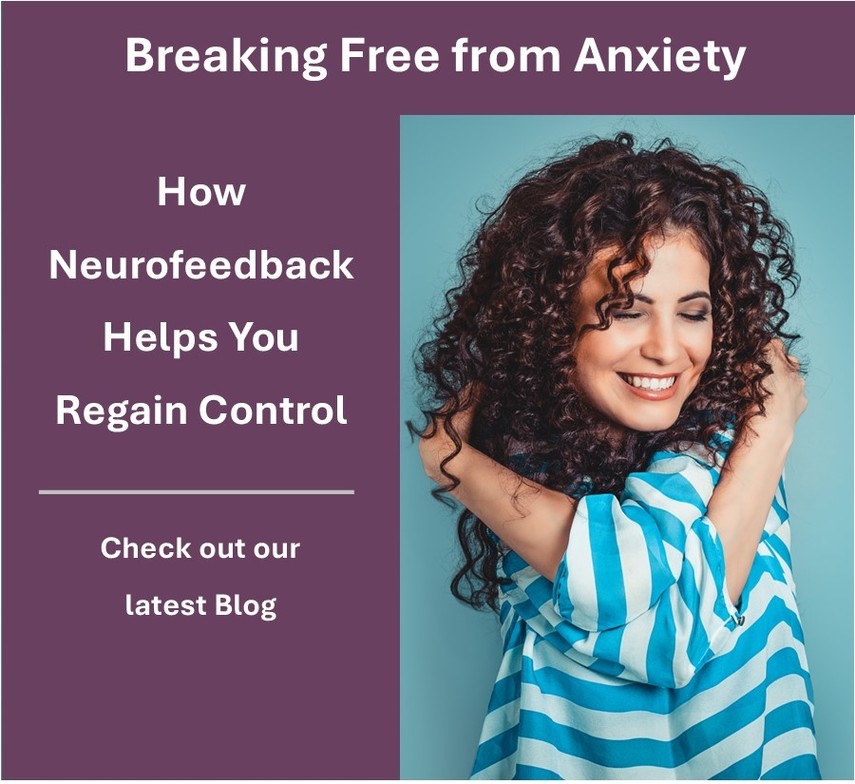
Breaking Free from Anxiety: How Neurofeedback Helps You Regain Control
Anxiety can feel like a constant weight, something that’s always there, holding you back from feeling at ease. For those who deal with chronic anxiety, it’s more than just occasional stress—it’s a daily presence that often gets in the way of life’s simplest moments. While many find relief in therapy or medication, there’s another approach that offers a different path forward. Neurofeedback offers a way to retrain the brain itself. Imagine being able to see your brain’s activity in real-time and, session by session, learning how to steer it toward calm. Neurofeedback is a therapeutic technique that uses brainwave monitoring to gently guide the brain into more balanced states. It taps into the brain’s own ability to regulate, opening new doors for lasting relief from anxiety. With neurofeedback, the focus isn’t on managing symptoms alone but on working with the root of the anxiety. Through repeated sessions, people not only gain insight into their brain’s patterns but also start to influence them actively. This isn’t about “mind over matter”—it’s about using technology to encourage the brain’s natural rhythms of calm and focus. As training progresses, people begin to reclaim a sense of control that may have felt out of reach for years. In this blog, we’ll explore how neurofeedback makes this change possible, why it works, and what real people have experienced along the way.
Table of Contents:
- Understanding anxiety at the brain level: how anxiety manifests in brain activity
- Neurofeedback’s approach: the process of training calming brainwaves
- Success rates and case studies
Understanding Anxiety at the Brain Level: how anxiety manifests in brain activity
Anxiety doesn’t just affect the way we feel—it’s fixed in how our brains function. When we experience anxiety, it’s not just a “feeling” but a pattern of brain activity that can become overactive and hard to quiet down. Specific regions of the brain play a role in this, including the amygdala, which acts as the brain’s alarm system, and the prefrontal cortex, which helps us think through and manage emotions. When these areas are in balance, the brain can respond calmly and rationally to stress. But when anxiety takes hold, this balance is disrupted. In moments of anxiety, the amygdala can become hyper-alert, scanning for threats even when there aren’t any real dangers around. This heightened state of alertness causes the brain to release stress hormones, which create that familiar “fight or flight” response. The prefrontal cortex, which normally steps in to calm things down, often struggles to keep up, making it harder to think clearly or find perspective. Over time, these reactions can become so ingrained that the brain starts to react this way almost automatically, even in everyday situations. Neurofeedback addresses these patterns by identifying where the brain is locked into these high-alert states and encouraging it to change back toward a state of calm. By retraining these areas of the brain, especially those connected to stress responses, neurofeedback helps to re-establish the balance that anxiety disrupts. Instead of just coping with anxious feelings, neurofeedback enables the brain to learn a new way of responding—one that supports relaxation and resilience over time.
Neurofeedback’s approach: the process of training and calming brainwaves
Neurofeedback works by training the brain to recognize and adopt patterns that encourage calm and focus. Using advanced technology, neurofeedback provides real-time feedback on brainwave activity, which helps the brain “see” itself in action. This feedback loop enables the brain to adjust and fine-tune its activity, just as you might adjust your posture by watching yourself in a mirror. Here’s how the process works: during a neurofeedback session, sensors are placed on specific points on the scalp to monitor brainwave activity. The brain naturally produces different types of brainwaves depending on your state of mind. For instance, relaxed states are associated with alpha and theta waves, while high-alert states show increased beta waves. In cases of chronic anxiety, the brain may become accustomed to producing an excess of these high-alert beta waves, which can make calm states harder to reach. As the neurofeedback system picks up these brainwave patterns, it provides immediate feedback through visual or auditory cues. For example, if your brain generates calm alpha waves, you might see a soothing visual or hear pleasant tones as positive reinforcement. When the brain changes back to high-alert patterns, the feedback changes, gently encouraging it to return to a calmer state. Over time, the brain learns to associate these calming waves with positive feedback, building a new pattern that prioritizes calm over stress. With consistent training, neurofeedback sessions help the brain become more familiar with states of relaxation. Just like practicing a new skill, the brain becomes better at finding and sustaining these balanced states, making it easier to respond to life’s stresses without slipping back into anxiety. By creating a lasting change in how the brain manages stress, neurofeedback offers more than symptom relief; it helps the brain learn a new rhythm of calm and resilience.
Success Rates and Case Studies
Neurofeedback has shown impressive results in reducing anxiety by helping the brain reshape its response to stress. In clinical studies, participants who received neurofeedback reported feeling fewer anxious thoughts and experiencing a calmer approach to everyday stress. Remarkably, these effects often last well beyond the training period, with benefits still noticeable months later[1]. In one study with 34 participants facing anxiety disorders, personalized neurofeedback sessions focused on specific brainwave patterns led to significant reductions in stress. The sessions used real-time EEG feedback to help participants increase calming alpha waves, gradually training their brains to stay in a more relaxed state[2]. Another study with individuals experiencing high levels of trait anxiety found that boosting alpha waves in the brain’s frontal areas not only eased mental tension but also reduced physical signs of anxiety[3]. For these participants, neurofeedback transformed their stress responses, making anxiety a more manageable part of daily life. Real-world stories highlight the effectiveness of neurofeedback as well.
Take Sarah, a college student who had struggled with chronic anxiety since her teens. Everyday tasks like attending classes or interacting with new people were overwhelming for her. After completing 20 neurofeedback sessions, Sarah began to notice a steady change in how she responded to stress. Her anxiety no longer spiraled out of control at the first sign of pressure, and she felt more equipped to manage her workload and social situations with ease.
Then there’s James, a working professional who had been dealing with high-stress levels in his job. His anxiety made it difficult for him to focus or make decisions, and he often felt physically tense. After trying traditional methods with little success, he began neurofeedback training. Over the course of a few months, James found his physical tension eased, and he was better able to handle stressful situations at work without feeling overwhelmed. Neurofeedback doesn’t just reduce anxiety in the moment but helps retrain the brain for lasting resilience. With time, the brain adopts these new, calmer patterns as its default, making neurofeedback a powerful, evidence-based tool in the journey to overcoming chronic anxiety.
A Life-Changing Path to Calm For those dealing with chronic anxiety, neurofeedback offers a new and hopeful path. Unlike traditional methods that focus primarily on managing symptoms, neurofeedback targets the brain’s actual response patterns, helping individuals retrain how they process stress and regulate emotions. By reinforcing brainwave patterns connected to calm and focus, neurofeedback enables people to regain control over anxiety rather than just coping with it. Studies consistently show that neurofeedback can reduce anxiety by 40-60%, with lasting effects long after training concludes. Real-world cases, from young adults facing the stresses of daily life to professionals grappling with high-stakes careers, reveal that neurofeedback can make a substantial difference. People who once felt overwhelmed by anxious thoughts report feeling more in control, resilient, and equipped to handle whatever life brings. [1]
https://www.researchgate.net/publication/8163422_Neurofeedback_with_anxiety_and_affective_disorders [2] https://www.frontiersin.org/journals/neuroscience/articles/10.3389/fnins.2021.758068/full [3] https://www.neuroregulation.org/article/view/18584/12141
Dr. Janell Matz
Contact Me


